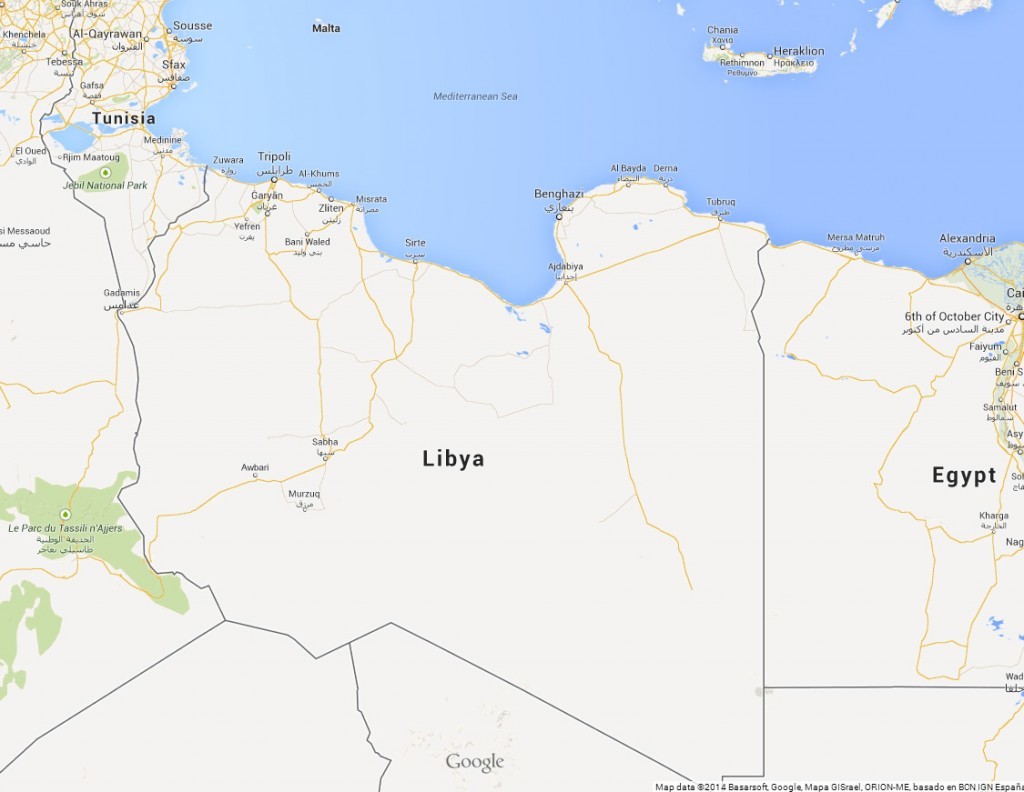
Escalating conflicts in Libya are thwarting a revival of oil output from Africa’s largest crude reserves after a yearlong blockade of eastern ports, just as Societe Generale SA and Barclays Plc predict rising demand.
While the government said in early July that traders could buy cargoes again from Es Sider and Ras Lanuf, the biggest blocked ports, neither has shipped anything. In Tripoli, the capital, firefighters are still battling a blaze at a fuel- storage depot caused by clashes between militias that have been struggling for political power in the three years since the ouster and killing of long-time leader Muammar Qaddafi.
Brent crude futures have been trading as if supplies would be ample. Near-term contracts are priced at a discount to deliveries later in the year, a pattern known as contango, since July 8, the longest stretch in four years. Societe General and Barclays are among the banks predicting the discounts won’t last, with accelerating global growth driving global oil demand by more than Libya produced in any year since 1979.
“Investors became very excited about the reopening and underestimated the technical issues that have held up the resumption of exports,” Riccardo Fabiani, a London-based analyst at Eurasia Group, a political-risk group that specializes in energy. “They are only now coming to grips with a more complex picture.”
The US State Department evacuated its Libyan embassy on July 26 because of the violence, while the UK and Canada also withdrew diplomatic staff. With conflicts in the North African country becoming more widespread and deadly, “the prospect of increasing exports is starting to look a lot bleaker,” Citigroup Inc. said in a report yesterday.
Brent crude for September delivery traded at $107.27 a barrel as of yesterday on the ICE Futures Europe exchange, compared with $107.62 for the October contract and $107.80 for December. Prices for immediate delivery have traded at a discount to later ones for 17 straight sessions, the longest stretch since the end of 2010, exchange data show.
On July 16, the last day of trading for the August contract, the discount to September futures was $1.32 a barrel, prompting firms including Bank of America Corp. and Energy Aspects Ltd. to speculate it would be profitable for traders to buy crude at the current price, store it, and sell later.
“Everyone is very excited about what’s happening to the prompt Brent spread, but I don’t think that’s indicative of a total market collapse, or anything even resembling it,” said Seth M. Kleinman, Citigroup’s head of European energy research. “If you’re buying crude for your refinery, all you care about is it’s reliably there, and you can’t say that’s going to be the case for Libya.”
The clashes, between an anti-Islamist militia aligned with a renegade general and pro-Islamists, are a spinoff of violence in the eastern region between Islamist militants and their opponents, headed by General Khalifa Haftar. Rivalries between militias, which have often doubled as national security forces, have undercut the already-weak central government’s ability to exert influence and stabilize the nation.
Production in Libya reached 1.7 million barrels a day in 2008 and was almost 1.6 million before Qaddafi’s death in 2011. Output has tumbled since then as unrest and political instability increased. Earlier this year, Libya became the smallest supplier in the Organization of Petroleum Countries and shipped 300,000 barrels a day in June, according to data compiled by Bloomberg.
A sustained resumption by Libya could help to maintain the contango. Brent’s premium to West Texas Intermediate, the main US equivalent, was about $6.75 a barrel yesterday, the highest since April.
Libya’s oil is similar to the Brent crude from the North Sea that is a European benchmark. Both are low in sulfur and less dense than other types, meaning they can yield a greater proportion of high-value products including gasoline and jet fuel.
“If a refiner buys cheap crude from Libya, he is not necessarily there to buy North Sea barrels that he would otherwise have been interested in,” Torbjorn Kjus, an analyst at DNB ASA, Norway’s biggest bank, said by e-mail on July 23. “A pickup in exports as a result could blow out the contango even further.”
While extra Libyan cargoes would add supplies, there’s also likely to be less shipped from the North Sea. Producers in the region are poised to undergo yearly maintenance next month, reducing the pool of crudes available.
Shipments of Brent, Forties, Oseberg and Ekofisk crudes, the grades that make up the physical price of Brent, will drop to a 14-month low of about 755,000 barrels a day next month, according to loading programs obtained by Bloomberg.
That will occur at a time of strengthening demand. Daily global use will increase 1.97 million barrels to a record 93.63 million in the second half of this year, according to the International Energy Agency, an adviser to 29 oil-consuming nations.
Nations including Saudi Arabia may adjust their output if Libya ships more, according to Mike Wittner, an analyst at Societe Generale in New York.
Libya’s supply resumption will be uneven, and fighting around Tripoli could mean output declines if international oil companies evacuate more workers, according to Miswin Mahesh, an analyst at Barclays in London.
“Further weakness on Brent from current levels is likely to be limited until we see exports from Libya actually materialize in a sustainable manner,” Mahesh said. “That’s unlikely given the increasingly fragile state of affairs.”
Recommended for you
